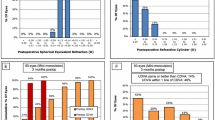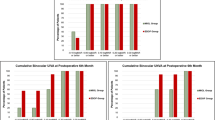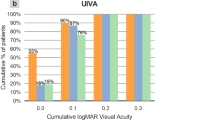Abstract
To assess the level of visual function and the influence of personality traits on patients’ (pts) satisfaction with the visual function following the four different MIOL implantation.
Methods
We evaluated the visual outcomes over a 6 months follow-up period after cataract surgery with bilateral implantation of four different multifocal IOLs. The spectacle independence, photic phenomena, the influence of personality traits on patients’ satisfaction with the visual function were assessed.
Results
A total of 170 eyes of 85 pts were included. There was no statistically significant difference in UDVA (F = 1.6 p = 0.177) and CNVA (F = 1.2 p = 0.30) between the groups 6 months after the surgery. The ReSTOR group had a worse CDVA than the M-flex (p = 0.019) and TECNIS (p = 0.005) groups. The ReSTOR and AT.LISAtri groups had a statistically significantly better UNVA than the M-flex (p = 0.020 and p = 0.013) and TECNIS groups (p = 0.001 both). The independence on spectacles for near distance was from 71.8% (in M-flex group) to 100% (in ReSTOR). The answers of the pts with the prevailing neurotic personality type contradicted the answers given by the pts with other prevailing personality types (p < 0.01).
Conclusions
MIOL implantation helped ensure better postoperative visual acuity, but some pts were unhappy with the postoperative outcomes. It was established that the subjective satisfaction or dissatisfaction of patients after MIOL implantation is related to certain personality traits: pts with neuroticism as the dominant personality trait were least happy with the postoperative outcomes; pts with conscientiousness and agreeableness as dominant personality traits demonstrated the highest satisfaction with the postoperative outcomes.
Similar content being viewed by others
Log in or create a free account to read this content
Gain free access to this article, as well as selected content from this journal and more on nature.com
or
References
Sharma KK, Santhoshkumar P. Lens aging: effects of crystallins. Biochim Biophys Acta. 2009;1790:1095–108.
Becker KA, Martin M, Rabsilber TM, Entz BB, Reuland AJ, Auffarth GU. Prospective, non-randomised, long term clinical evaluation of the foldable hydrophilic single piece intraocular lens: results of Centerflex FDA study. Br J Ophthalmol. 2006;90:971–4.
Vilaseca M, Arjona M, Pujol J, Issolio L, Guell JL. Optical quality of foldable monofocal intraocular lenses before and after injection: comparative evaluation using a double-pass system. J Cataract Refract Surg. 2009;35:1415–23.
Lane SS, Morris M, Nordan L, Packer M, Tarantino N, Wallace RB III. Multifocal intraocular lenses. Ophthalmol Clin North Am. 2006;19:89–105.
Bellucci R. Multifocal intraocular lenses. Curr Opin Ophthalmol. 2005;16:33–7.
Kohnen T, Allen D, Boureau C, Dublineau P, Hartmann C, Mehdorn E, Rozot P, Tassinari G. European multicenter study of the AcrySof ReSTOR apodized diffractive intraocular lens. Ophthalmology. 2006;113:578–84.
Alfonso JF, Puchades C, Fernandez-Vega L, Montes-Mico R, Valcarcel B, Ferrer-Blasco T. Visual acuity comparison of 2 models of bifocal aspheric intraocular lenses. J Cataract Refract Surg. 2009;35:672–6.
Montes –Mico R, Espana E, Bueno I, Charman WN, Menezo JL. Visual performance with multifocal intraocular lenses; mesopic contrast sensitivity under distance and near conditions. Ophthalmology. 2004;111:85–96.
Leyland M, Zinicola E. Multifocal versus monofocal intraocular lenses in cataract surgery; a systematic review. Ophthalmology. 2003;110:1789–98.
Woodward MA, Randleman JB, Stulting RD. Dissatisfaction after multifocal intraocular lens implantation. J Cataract Refract Surg. 2009;35:992–7.
Braga-Mele R, Chang D, Dewey S, Foster G, An Henderson B, Hill W, Hoffman R, Little B, Mamalis N, Oetting T, Serafanao D, Talley-Rostov A, Vasavada A, Yoo S. Multifocal intraocular lenses: relative indications and contraindications for implantation. J Cataract Refract Surg. 2014;40:313–22.
Goes FJ. Visual results following implantation of a refractive multifocal IOL in one eye and a diffractive multifocal IOL in the contralateral eye. J Refract Surg. 2008;24:300–5.
John OP, Srivastava S. The Big Five trait taxonomy: History, measurement, and theoretical perspective. Handbook of personality: Theory and research. 1999;4:102–38.
Zhang LF. Thinking styles and the Big Five personality traits. Educ Psychol 2002;22:17–31.
Kairys A. Didysis penketas: už ir prieš. Psichologija 2008;37:71–84.
Bukšnytė-Marmienė L, Kovalčikienė K, Ciūnytė A. Didžiojo penketo asmenybės bruožų ir kognityvinio stiliaus sąsajos. Tarptautinis psichologijos žurnalas: biopsichosocialinis požiūris 2012;10:125–43.
McCrae RR, Terracciano A. Universal features of personality traits from the observer’s perspective: data from 50 cultures. J Personal Soc Psychol 2005;88:547–61.
Mount MK, Barrick MR, Scullen SM, Rounols J. Higher – order dimensions of the Big Five personality traits and the big six vocational interest types. Personal Psichol 2005;58:447–78.
Durrett C, Trull TJ. An evaluation of evaluative personality terms: a comparison of the big seven and five-factor model in predicting psychology. Psychol Asssess 2005;17:359–68.
Cuijpers P, van Straten A, Donker M. Personality traits of patients with mood and anxiety disoders. Psychiatry Res 2005;133:229–37.
Weiss A, Costa PT. Domain and facet personality predictors of all—cause mortality Medicare patients aged 65 to 100. Psychom Med 2005;67:724–33.
Goldberg LR. A broad-bandwidth, public domain, personality inventory measuring the lower-level facets of several five-factor models. Personal Psychol Eur 1999;7:7–28.
Bunevičius A, Katkutė A, Birbilaitė I. Validity of Lithuanian version of the Modern Personality Assessment based on the Big-Five personality dimensions questionnare. Biol Psychiatry Psychopharmacol 2008;10:27–30.
Bunevičius A. Didžiojo penketo asmenybės dimensijos. Biol Psychiatry Psychopharmacol 2005;6–7:34.
Žukauskienė R, Barkauskienė R. Lietuviškosios NEO PI-R versijos psicho-metriniai rodikliai. Psichologija 2006;33:7–21.
Agresta B, Knorz MC, Kohnen T, Donatti C, Jackson D. Distance and near visual acuity improvement after implantation of multifocal intraocular lenses in cataract patients with presbyopia: a systematic review. J Refract Surg. 2012;28:426–35.
Toto L, Falconio G, Vecchiarino L, Scorcia V, Di Nicola M, Ballone E, Mastropasqua L. Visual performance and biocompatibility of 2 multifocal diffractive IOLs; six-month comparative study. J Cataract Refract Surg. 2007;33:1419–25.
De Vries NE. Nuijts RMMA. Multifocal intraocular lenses in cataract surgery: literature review of benefits and side effects. J Cataract Refract Surg. 2013;39:268–78.
Davison JA, Simpson MJ. History and development of the apodized diffractive intraocular lens. J Cataract Refract Surg. 2006;32:849–58.
Hayashi K, Manabe S-i, Yoshida M, Hayashi H. Effect of astigmatism on visual acuity in eyes with diffractive multifocal intraocular lens. J Cataract Refract Surg. 2010;36:1323–9.
Zelichowska B, Rekas M, Stankiewicz A, Cervino A, Montes-Mico R. Apodized diffractive versus refractive multifocal intraocular lenses: optical and visual evaluation. J Cataract Refract Surg. 2008;34:2036–42.
Vingolo EM, Granga P, Iacobelli L, Grenga R. Visual acuity and contrast sensitivity; AcrySof ReSTOR apodized diffractive versus AcrySof SA60AT monofocal intraocular lenses. J Cataract Refract Surg. 2007;33:1244–7.
Alio JL, Grabner G, Plaza-Puche A, Rasp M, Pinero DP, Seyeddain O, Rodriguez-Prats J, Ayala MJ, Moreu R, Hohensinn M, Riha W, Dexl A. Postoperative bilateral reading performance with 4 intraocular lens models: six-months results. J Cataract Refract Surg. 2011;37:842–52.
Lichtinger A, Rootman DS. Intraocular lenses for presbyopia correction: past, present, and future. Curr Opin Ophthalmol. 2012;23:40–6.
Tabrett DR, Latham K. Adjustment to vision loss in a mixed sample of adults with established visual impairment. Investiga Ophthalmol Vis Sci. 2012;53:7227–33.
Suls J, Martin R. The daily lifr of the garden–variety neurotic: reactivity, stressor exposure, mood spillover, and maladaptivite coping. J Personal. 2005;73:1485–510.
Funding
This work was funded by Lithuanian University of Health Sciences and Kaunas University of Technology.
Author information
Authors and Affiliations
Corresponding author
Ethics declarations
Conflict of interest
The authors declare that they have no conflict of interest.
Additional information
Publisher’s note Springer Nature remains neutral with regard to jurisdictional claims in published maps and institutional affiliations.
Supplementary information
41433_2019_585_MOESM1_ESM.docx
Supp' Tables 1–3: Relations Between Patient Personality and Patients` Dissatisfaction After Multifocal Intraocular Lens Implantation: Clinical Study Based on the Five Factor Inventory Personality Evaluation
Rights and permissions
About this article
Cite this article
Rudalevicius, P., Lekaviciene, R., Auffarth, G.U. et al. Relations between patient personality and patients‘ dissatisfaction after multifocal intraocular lens implantation: clinical study based on the five factor inventory personality evaluation. Eye 34, 717–724 (2020). https://doi.org/10.1038/s41433-019-0585-x
Received:
Revised:
Accepted:
Published:
Issue date:
DOI: https://doi.org/10.1038/s41433-019-0585-x
This article is cited by
-
Risk factors in self-reported dissatisfied patients implanted with various presbyopia-correcting intraocular lenses after cataract surgery
BMC Ophthalmology (2025)
-
Evidenzbasierter Einsatz von Sonderlinsen: Management von postoperativer Unzufriedenheit
Die Ophthalmologie (2025)
-
Neuroadaptation to multifocal intraocular lenses: preliminary observations of a cognitive influence
Graefe's Archive for Clinical and Experimental Ophthalmology (2025)
-
Early intraocular lens explantations: 10-year database analysis
BMC Ophthalmology (2024)
-
Tolerance to residual astigmatism of an isofocal intraocular lens
Graefe's Archive for Clinical and Experimental Ophthalmology (2024)



